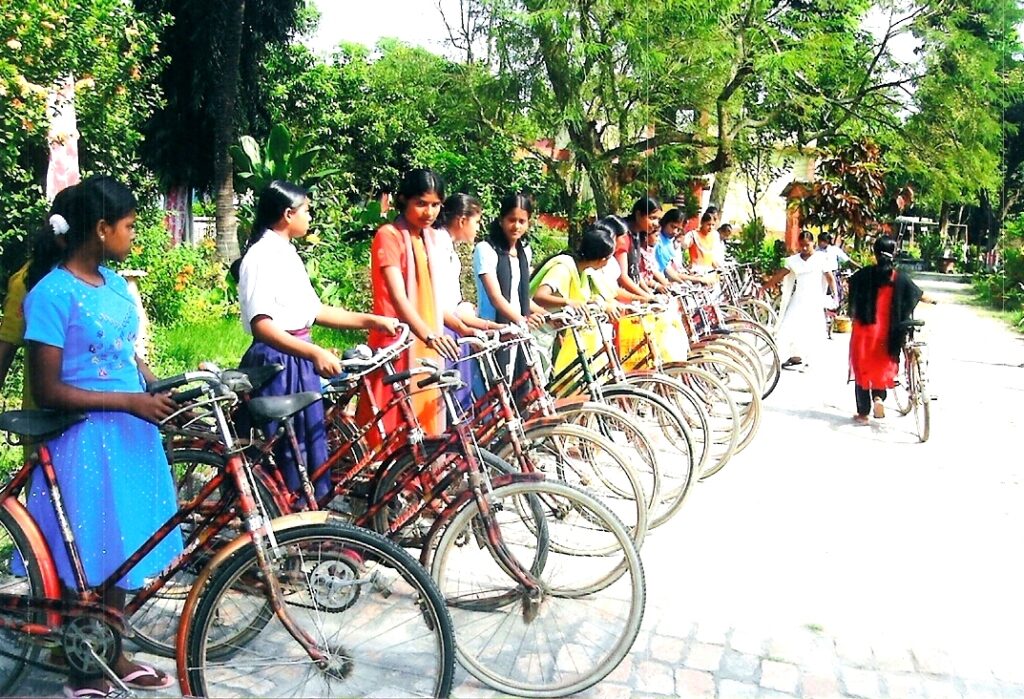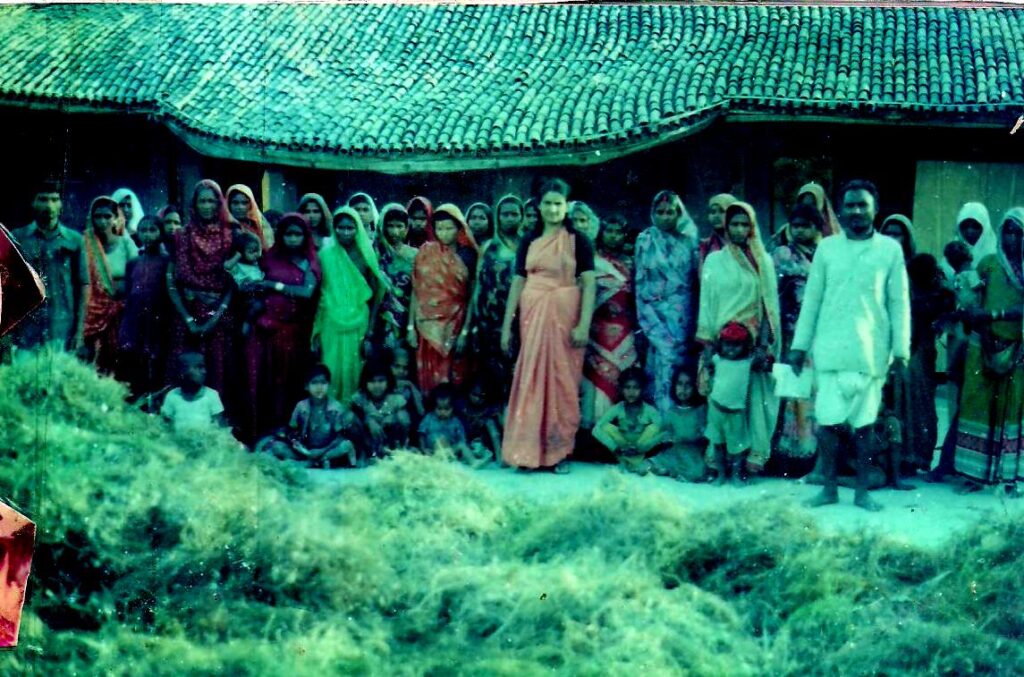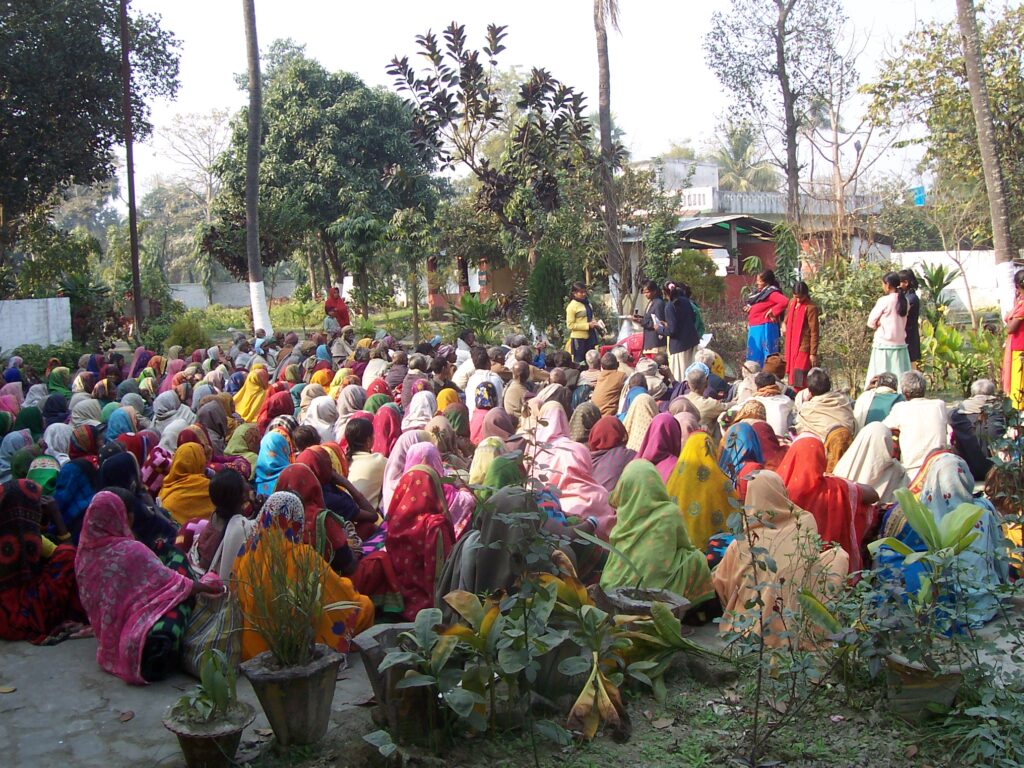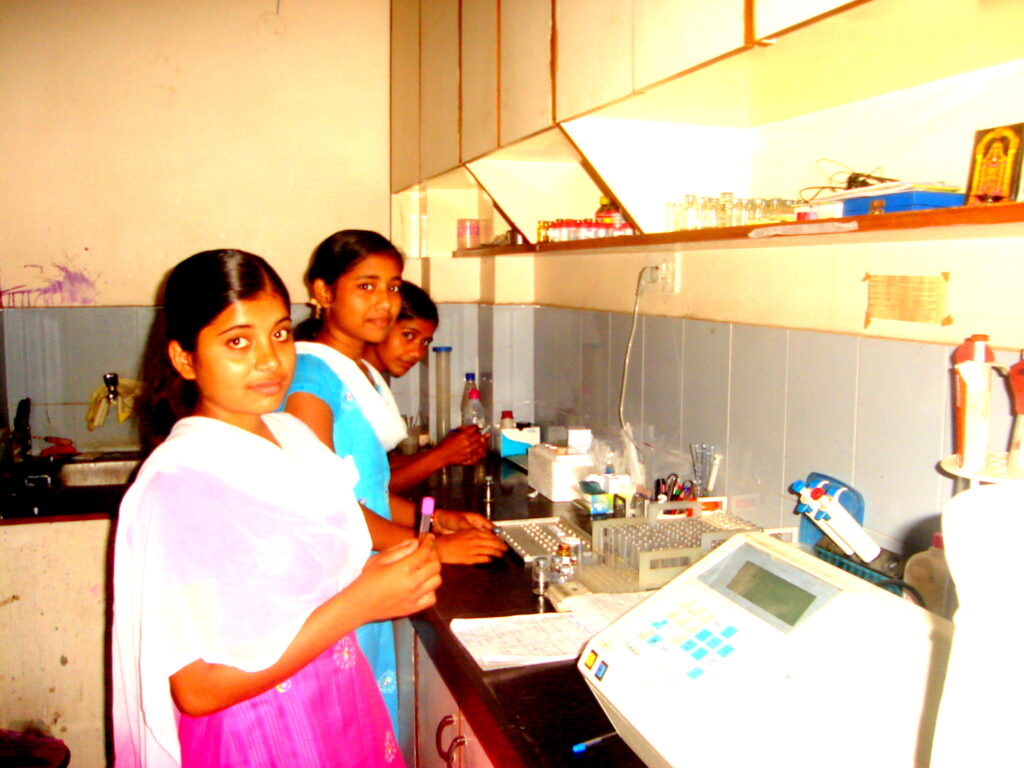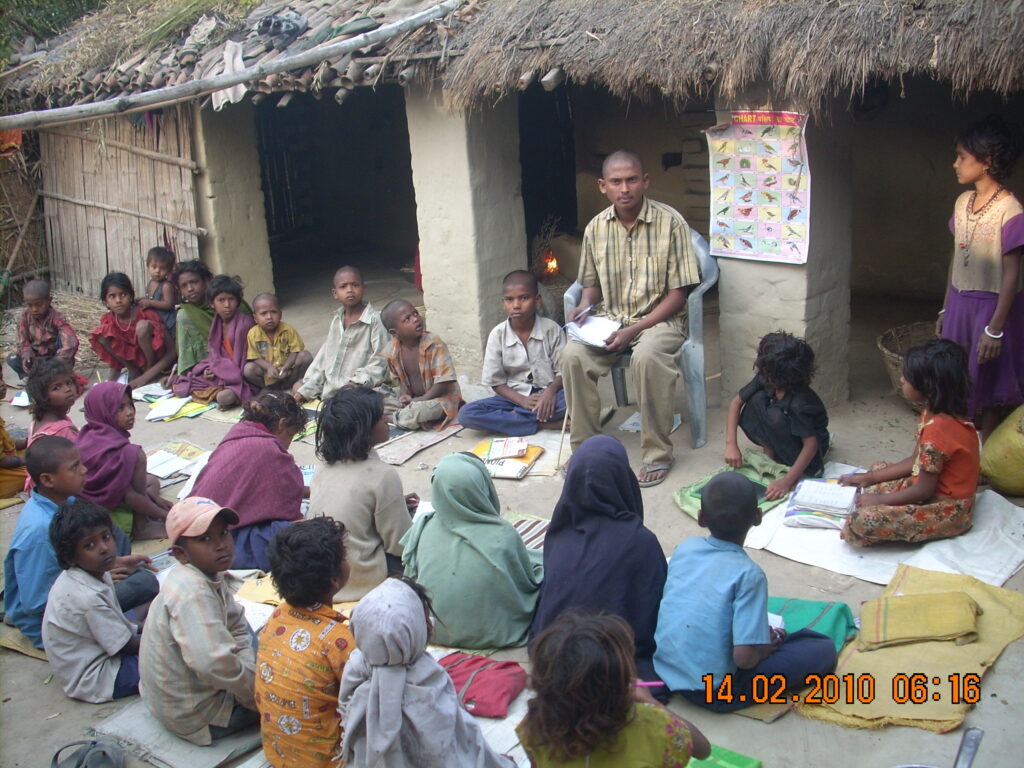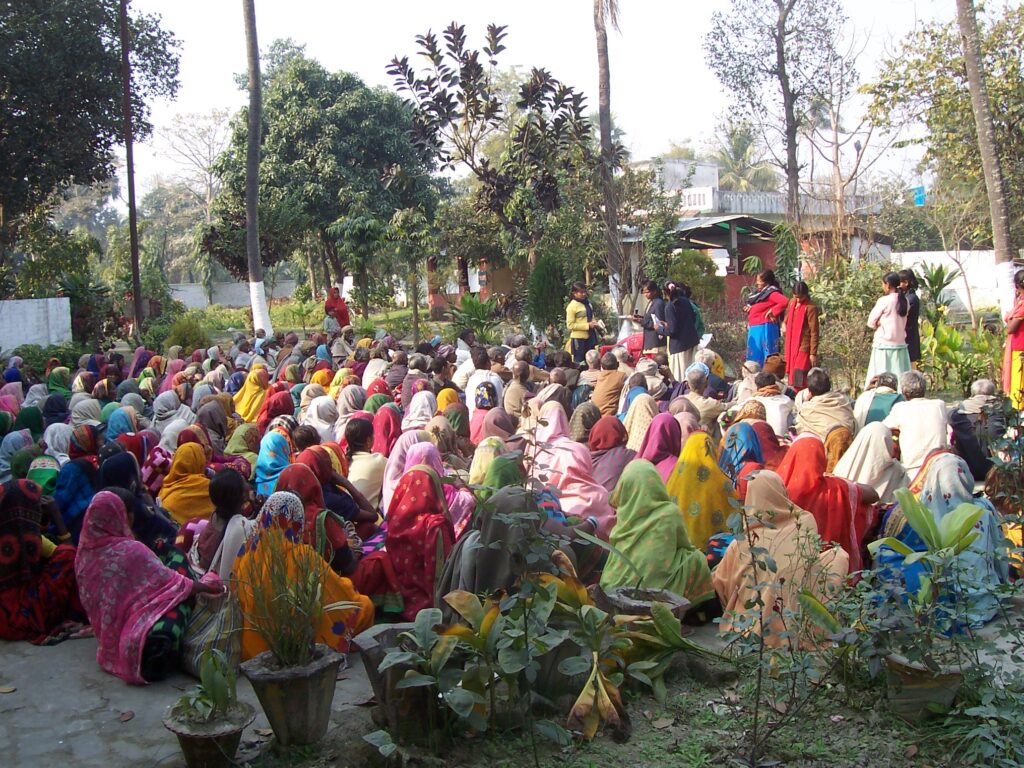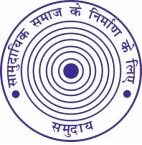Samuday got registered in 1980. The work of Samuday started with 6 villages and in the course of 10 years it blossomed into 100 villages around the center of the organization, i.e- Rosera (Bihar). This expansion was not abrupt. It was a gradual and natural expansion created by the village worker’s network of Samuday.
Samuday being a women headed organization so we decided, women have to be the focus of our work.
We emphasized first social awakening, then enthusing them to stand on their own feet. The organization till date has been able to train around 500 illiterate Harijan women as health workers and benefited 5000 families. Equipped with the knowledge of health Education and trained for primary treatment of common diseases, they were effectively providing these services in their working areas. They also worked for as making women aware about the connection between poor health and second class social status of women.
A Glimps of our work area – Rusera
The area Rusera where we are working is situated in North Bihar (Dist. Samastipur). There are no industries and the area is totally agrarian and as the distribution of land is unequal and the culture is very much feudal, the exploitation of poor people is very crude. A section of these poor people is Harijan population of the area. The Harijans are socially and economically the most backward people and almost all of them are professionally are landless labourers.
The wage of the Harijan labourers is much less i.e. Rs. 15 to 25 per day. Moreover they get work in the area maximum for 6 to 8 months only depending upon condition of the agriculture. As the area is flood prone the problem of earning ones livelihood becomes more difficult and uncertain.
Since last 10 to 15 years the land labourers began to migrate to Punjab, Delhi, Calcutta or Assam only to earn their livelihood leaving their women folk and children behind. Almost 75% of the active men have to migrate. This migration helps them in earning more money for their families but the condition of their life does not seem to have changed. The feudal exploitation is the main cause of their poverty and due to their migration it increases and remains unchallenged. The women folk in the villages become, more vulnerable to different faces of this feudal exploitation.
We are working in this area for last ten years, our main target groups are Harijan women and children. Now we are working in about fifty villages. We have trained atleast one women in every village as health worker and are running non-formal education centers for children, particularly girl children in few villages. This was to make village women aware and organized so that they can resist exploitation and make their life better.
MITHILA REGION (in which Rusera is situated)
East of the Gandak Basin almost whole of north Bihar is considered Mithila region, but its central parts are more homogeneous in terms of language and culture of Mithila. In existing demarcation Mithila Region is restricted to the five administrative districts of Madhubani, Darbhanga, Samastipur, Saharsa, and Madhepura, Geographically it is the river basin of Adhwara-group of rivers and Koshi river. Because the country slope one eastern extremity of northern plains is the south west ward, a bowl like topography exists, that is situated around the southern fringe of this central part of north Bihar. This puts the region to a further disadvantage situation as several of the north Bihar Rivers converge here for confluence. As a fall out, this area becomes the centre of the flood-catchments in the whole of north Bihar. Constructions of major barrages and bandhs along some of these rivers have only aggravated the flood-situations. There are large areas in the region which is found submerged under water for the whole calendar year, pushing this agrarian society to great hardships. The region is also dotted with large number of land depressions called ‘Chaurs’ which are permanently waterlogged areas. Rivulets, dead channels of river and marshes are also a typical feature of the region. Though these geographical features provide a kind of immunity from occurrence of drought, but also impose limitations to a bountiful harvest. The area is also typically prone to health-hazards. Another notable feature is the fact that throughout the ages of traditional agriculture it remained attractive for new settlers. As a result, in population it is one of the highest density areas in the whole country.
ROSERA AND THE IMMEDIATE HINTERLAND
Quite in remote of Samastipur district lays Rosera which has been elevated to sub-division status in recent years. Administratively it was only a block earlier and because of being a rail-head, and an important commercial centre in the days of river-borne trade that a small township existed here since the early decades of 19th century.
Historically, once the rail and road communication developed, the volume of trade substantially dwindled pushing the township to a stage of decline though it is one of the oldest municipal towns in Bihar. The total urban area is only 1.05sq. kms. as recorded in 2001-census. Ravages of floods as well as innumerable ditches, nullahs, rivulets, chaurs etc. have also made it somewhat inaccessible. Battered roads and bridges also prevent any faster road-communication.
The most striking feature of the region is its dependence on migrant labour. A large number of young people migrate to take seasonal work or on routine casual works – mostly in northern states, or in other distantly urban and industrial centers. Moreover because of the large scale influx, much of the routine work of poor families is performed by women. Though the remittances sent home by migrants have provided some comfort to their domestic economy, it has also added a lot of tensions and new kind of problems faced by women as singularly running their spouse, or under joint families.
ROSERA
| Area in square kilometers | 245.3 |
| Number of Inhabited villages | 103 |
| Number of Panchayats | 24 |
| Number of occupied Households | 35.17 |
| Population (In lakhs)
[Estimated number for 1997] |
2.98 |
| Percentage of schedule caste population in total | 17.21% |
General Distribution of Female Population in particular age groups:
| 0-14 years | 15-44 years | 45-above |
| 39.6% | 43.4% | 17.00% |
CULTURE OF DEPRIVATION AND ASPECTS OF WOMEN
The array of thought that Samuday has developed does not dwell on stereo-types of identifying layers of poverty nor on income-generation strategy for poverty alleviation assuming as usual that a much of the social maladies are plainly associated with poverty. Sharply in contrast, it believes poverty in itself is ingrained in culture of deprivation that continues to pervade large social milieu. This culture stems in keeping women under bondage yet depriving them of social and economic freedom to any kind of creativity.
The thinking at Samuday is to address the very mode of social thinking that imposes handicaps on women that ultimately governs the society in all its life-ethos. Affecting physiological health to psychological and mental frame of women the culture acts on all kind of relationships in family and in overall social life.
Samuday therefore assumes that women have to be the focus of social awakening first enthusing them to stand on their own feet. Samuday has chosen a strategy of mobilizing women. Since much of their behavioral outlook is determined by the capacity of physical endurance and mental vitality, their physiological health is the key-factor in order to address them for any mobilization precisely it is physiological health that has to bear the brunt of economic social and emotional exploitation. Therefore efforts of mobilization have to begin with health awareness, which again is rooted in scientific knowledge of the female-body, or of prevalent diseases commonly afflicting them.
Samuday also identifies a number of social customs practiced against them that develops into mental crippling of the women. The analytical frame developed at Samuday points to the social imperatives that affect the women in a number of ways. Arguably the social system that does not welcome the birth of girl child, consistent neglect and discriminations leave them psychologically torn from the very childhood.
Addressing the health problems of the women is therefore the first step towards a greater social mobilization process f at all it is aimed for any meaningful change.
Bihar, today figures as a very tyrannical society. Gross incident of women-abuse is almost a daily news from this state. Frequent rapes, rapes with minors, even ghastly incidents of mass-rape are also not much uncommon. Torture of the brides, occasional murders, and even bride-burning is also quite frequent. Incidents of fetus-killing of female sex have risen to alarming proportions. All these facts speak for themselves about the traumatic state of women’s existence in the society of Bihar.
Along demographic considerations too, not only their social status, even a dwindling physiological existence is more than reflected. A perceptible declining trend in female population is quite obvious. From near-equal population size (984 female/per 1000 male) in the fifties it has consistently been declining to a lowly 911 female/per 1000 male in 1991. Even in physical appearance, a weak configuration and a typical anemic face is also quite conspicuous. Among literate, their population size is only 23% against the national average of 39% while in work-participation too their relative size is dismally low to only 15% against the national average of 22%. Child marriage, early motherhood and a high fertility estimated along total fertility rate (TFR), against the national average of 3.4 children per woman, Bihar has got 18% higher fertility rate of 4 children per woman.
Given the above scenario Samuday decided to focus the work on women and adolescent girls of backward class.
FCRA details
FCRA
- Barefoot doctors (Baksa Vali)
- Cycle project
- Non formal Education project for children
- Flood relief work
- Stree Shakti Vahini Sangathan
Non–FCRA projects
- Scholarship project for adolescent girls
- Residential education project for adolescent girls
- Blanket distribution
Address:
Branch office
Ashiyana\Samuday, Near Badi Durga Sthan, Pancho Pur Road, Rusera, Dist.-Samastipur, Bihar, Pincode- 848210
Main office:
A wing, flat no. 205, Moti Apartment, Ram Jaypal Road, Gola Road, Patna, Bihar, Pincode – 801503.
Contact number – +919264264665
Mail ID – samuday1980@gmail.com
| Society Registration | Registration Under the society act, founded in 1980 with registration number |
| FCRA registration number | 031330002 |
| 12 (A) registration number | AADTS4223LE19854 |
| 80 (G) registration number | AADTS4223LF20017 |
| CSR registration number | CSR00030621 |
| PAN | AADTS4223L |
| TAN | |
| NGO Samuday Uniuqe ID | |
| FCRA Contributors |
|
